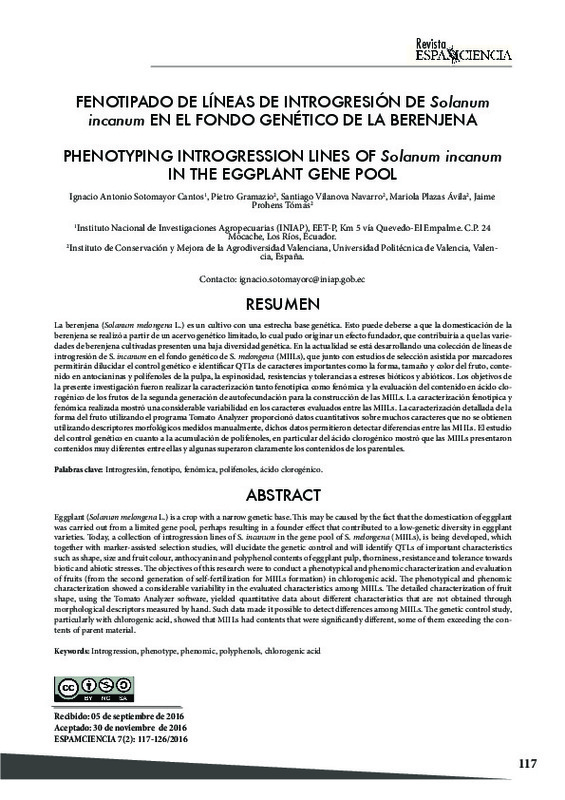JavaScript is disabled for your browser. Some features of this site may not work without it.
Buscar en RiuNet
Listar
Mi cuenta
Estadísticas
Ayuda RiuNet
Admin. UPV
Fenotipado de líneas de introgresión de Solanum incanum en el fondo genético de la berenjena
Mostrar el registro sencillo del ítem
Ficheros en el ítem
| dc.contributor.author | Sotomayor Cantos, Ignacio Antonio
|
es_ES |
| dc.contributor.author | Gramazio, Pietro
|
es_ES |
| dc.contributor.author | Vilanova Navarro, Santiago
|
es_ES |
| dc.contributor.author | Plazas Ávila, María de la O
|
es_ES |
| dc.contributor.author | Prohens Tomás, Jaime
|
es_ES |
| dc.date.accessioned | 2018-02-06T08:27:14Z | |
| dc.date.available | 2018-02-06T08:27:14Z | |
| dc.date.issued | 2016 | es_ES |
| dc.identifier.uri | http://hdl.handle.net/10251/96985 | |
| dc.description.abstract | [ES] La berenjena (Solanum melongena L.) es un cultivo con una estrecha base genética. Esto puede deberse a que la domesticación de la berenjena se realizó a partir de un acervo genético limitado, lo cual pudo originar un efecto fundador, que contribuiría a que las variedades de berenjena cultivadas presenten una baja diversidad genética. En la actualidad se está desarrollando una colección de líneas de introgresión de S. incanum en el fondo genético de S. melongena (MIILs), que junto con estudios de selección asistida por marcadores permitirán dilucidar el control genético e identificar QTLs de caracteres importantes como la forma, tamaño y color del fruto, contenido en antocianinas y polifenoles de la pulpa, la espinosidad, resistencias y tolerancias a estreses bióticos y abióticos. Los objetivos de la presente investigación fueron realizar la caracterización tanto fenotípica como fenómica y la evaluación del contenido en ácido clorogénico de los frutos de la segunda generación de autofecundación para la construcción de las MIILs. La caracterización fenotípica y fenómica realizada mostró una considerable variabilidad en los caracteres evaluados entre las MIILs. La caracterización detallada de la forma del fruto utilizando el programa Tomato Analyzer proporcionó datos cuantitativos sobre muchos caracteres que no se obtienen utilizando descriptores morfológicos medidos manualmente, dichos datos permitieron detectar diferencias entre las MIILs. El estudio del control genético en cuanto a la acumulación de polifenoles, en particular del ácido clorogénico mostró que las MIILs presentaron contenidos muy diferentes entre ellas y algunas superaron claramente los contenidos de los parentales. | es_ES |
| dc.description.abstract | [EN] Eggplant (Solanum melongena L.) is a crop with a narrow genetic base. This may be caused by the fact that the domestication of eggplant was carried out from a limited gene pool, perhaps resulting in a founder effect that contributed to a low-genetic diversity in eggplant varieties. Today, a collection of introgression lines of S. incanum in the gene pool of S. melongena (MIILs), is being developed, which together with marker-assisted selection studies, will elucidate the genetic control and will identify QTLs of important characteristics such as shape, size and fruit colour, anthocyanin and polyphenol contents of eggplant pulp, thorniness, resistance and tolerance towards biotic and abiotic stresses. The objectives of this research were to conduct a phenotypical and phenomic characterization and evaluation of fruits (from the second generation of self-fertilization for MIILs formation) in chlorogenic acid. The phenotypical and phenomic characterization showed a considerable variability in the evaluated characteristics among MIILs. The detailed characterization of fruit shape, using the Tomato Analyzer software, yielded quantitative data about different characteristics that are not obtained through morphological descriptors measured by hand. Such data made it possible to detect differences among MIILs. The genetic control study, particularly with chlorogenic acid, showed that MIILs had contents that were significantly different, some of them exceeding the contents of parent material. | es_ES |
| dc.language | Español | es_ES |
| dc.publisher | Escuela Superior Politécnica Agropecuaria de Manabí Manuel Félix López | es_ES |
| dc.relation.ispartof | Revista ESPAMCIENCIA (Online) | es_ES |
| dc.rights | Reconocimiento - No comercial - Compartir igual (by-nc-sa) | es_ES |
| dc.subject | Introgresión | es_ES |
| dc.subject | Fenotipo | es_ES |
| dc.subject | Fenómica | es_ES |
| dc.subject | Polifenoles | es_ES |
| dc.subject | Ácido clorogénico | es_ES |
| dc.subject.classification | GENETICA | es_ES |
| dc.title | Fenotipado de líneas de introgresión de Solanum incanum en el fondo genético de la berenjena | es_ES |
| dc.title.alternative | Phenotyping introgression lines of Solanum incanum in the eggplant gene pool | es_ES |
| dc.type | Artículo | es_ES |
| dc.rights.accessRights | Abierto | es_ES |
| dc.contributor.affiliation | Universitat Politècnica de València. Departamento de Biotecnología - Departament de Biotecnologia | es_ES |
| dc.contributor.affiliation | Universitat Politècnica de València. Instituto Universitario de Conservación y Mejora de la Agrodiversidad Valenciana - Institut Universitari de Conservació i Millora de l'Agrodiversitat Valenciana | es_ES |
| dc.description.bibliographicCitation | Sotomayor Cantos, IA.; Gramazio, P.; Vilanova Navarro, S.; Plazas Ávila, MDLO.; Prohens Tomás, J. (2016). Fenotipado de líneas de introgresión de Solanum incanum en el fondo genético de la berenjena. Revista ESPAMCIENCIA (Online). 7(2):117-126. http://hdl.handle.net/10251/96985 | es_ES |
| dc.description.accrualMethod | S | es_ES |
| dc.relation.publisherversion | http://investigacion.espam.edu.ec/index.php/Revista/index | es_ES |
| dc.description.upvformatpinicio | 117 | es_ES |
| dc.description.upvformatpfin | 126 | es_ES |
| dc.type.version | info:eu-repo/semantics/publishedVersion | es_ES |
| dc.description.volume | 7 | es_ES |
| dc.description.issue | 2 | es_ES |
| dc.identifier.eissn | 1390-8103 | es_ES |
| dc.relation.pasarela | S\328828 | es_ES |






